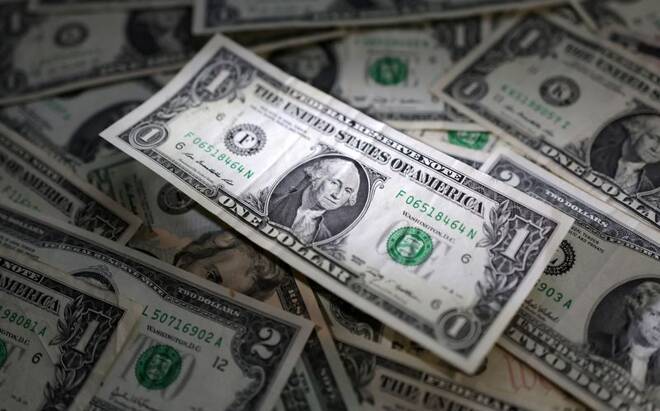Advertisement
Advertisement
U.S. dollar slumps after weak data; markets betting Fed near end of hiking cycle
By:
By Rae Wee SINGAPORE (Reuters) - The dollar wobbled on Tuesday after a slump in U.S. manufacturing activity last month pointed to further signs of a slowing economy and trumped renewed inflation concerns following OPEC+'s surprise output cut.
By Gertrude Chavez-Dreyfuss
NEW YORK (Reuters) – The U.S. dollar sank to a two-month low on Tuesday as another round of weak economic data reinforced investor bets that the Federal Reserve is nearly done with its tightening cycle even as other central banks are seen still raising interest rates to overcome persistently high inflation.
Sterling rose to a new 10-month high against the dollar, while the euro reached its highest since February.
Data showing U.S. job openings in February dropping to the lowest in nearly two years, and the continued decline in factory orders, undermined the dollar as the numbers indicated that rate hikes may be nearing an end.
Job openings, a measure of labor demand, decreased 632,000 to 9.9 million in February, the lowest since May 2021, according to the monthly Job Openings and Labor Turnover Survey, or JOLTS report.
“The main trigger was the JOLTS data, which is starting to point to labor market moderating. So we have this kind of grind lower in the dollar and we’re also looking at yields,” said Vassili Serebriakov, FX strategist at UBS in New York.
“The question is: Is the dollar hurt more by lower yields or is it helped more by weaker equities in the kind of risk-off environment? It seems like yields have a bigger impact.”
On Tuesday, U.S. two-year Treasury yields, which tend to reflect interest rate expectations, dropped 12 basis points (bps) to 3.86%. For the month of March, two-year yields plunged nearly 74 bps, the worst monthly fall since January 2008 in the midst of the global financial crisis.
U.S. factory orders also declined for a second straight month, down 0.7% in February after falling 2.1% in January.
In afternoon trading, the dollar index dropped to a two-month low of 101.45 and was last down 0.4% at 101.58.
“We have a lot of data to chew on this week that will either show that the U.S. economy is resilient enough to withstand the Fed’s ongoing rate-hike mentality or if markets will get their break,” said Juan Perez, director of trading at Monex USA in Washington.
“Add poor data to a banking crisis, plus the rise in oil supply costs, and you may get more favorable odds for rate cuts by next year.”
On Tuesday, the rate futures market priced in a roughly even chance of a 25-bp rate hike in May, with the rest of the odds tilted toward a pause from the Fed. On Monday, the probability of a 25-bp hike next month was more than 65%.
The rates market has also factored in Fed cuts by end-December.
Sterling rose to $1.2525, the highest since June 2022, after breaching a significant resistance level. The pound last changed hands at $1.2497, up 0.7%.
The euro reached $1.0973, the most in two months. It was last up 0.4% at $1.0951, with traders convinced that the European Central Bank has more rate hikes to come.
“We have the view for some time that the dollar has seen its peak and we’re sticking with it. We have a $1.15 forecast for the euro against the dollar in the second half,” UBS’ Serebriakov said.
The Reserve Bank of Australia (RBA), as expected, left its cash rate unchanged at 3.6%, breaking a run of 10 straight hikes as policymakers said additional time was needed to “assess the impact of the increase in interest rates to date and the economic outlook”.
The Australian dollar was last down 0.6% at US$0.6743.
Elsewhere, the dollar fell 0.6% against the Japanese yen to 131.635.
========================================================
Currency bid prices at 2:53PM (1853 GMT)
Description RIC Last U.S. Close Pct Change YTD Pct High Bid Low Bid
Previous Change
Session
Dollar index 101.5800 102.0300 -0.42% -1.846% +102.2700 +101.4500
Euro/Dollar $1.0952 $1.0903 +0.45% +2.21% +$1.0973 +$1.0884
Dollar/Yen 131.6600 132.4800 -0.62% +0.42% +133.1650 +131.5300
Euro/Yen 144.18 144.37 -0.13% +2.77% +145.4100 +143.9700
Dollar/Swiss 0.9058 0.9127 -0.75% -2.03% +0.9142 +0.9055
Sterling/Dollar $1.2495 $1.2417 +0.64% +3.33% +$1.2525 +$1.2398
Dollar/Canadian 1.3455 1.3440 +0.12% -0.69% +1.3467 +1.3407
Aussie/Dollar $0.6742 $0.6787 -0.64% -1.08% +$0.6793 +$0.6720
Euro/Swiss 0.9921 0.9947 -0.26% +0.26% +0.9971 +0.9914
Euro/Sterling 0.8765 0.8781 -0.18% -0.89% +0.8785 +0.8730
NZ $0.6299 $0.6297 +0.08% -0.76% +$0.6315 +$0.6274
Dollar/Dollar
Dollar/Norway 10.3070 10.2800 +0.38% +5.15% +10.3450 +10.2450
Euro/Norway 11.2904 11.2027 +0.78% +7.59% +11.3088 +11.2097
Dollar/Sweden 10.2794 10.3643 -0.29% -1.24% +10.3978 +10.2609
Euro/Sweden 11.2572 11.2902 -0.29% +0.97% +11.3195 +11.2436
(Reporting by Gertrude Chavez-Dreyfuss; Additional reporting by Alun John and Harry Robertson in London and Rae Wee in Singapore; Editing by Edmund Klamann, Bernadette Baum, Sharon Singleton, Andrea Ricci and Mark Heinrich)
About the Author
Reuterscontributor
Reuters, the news and media division of Thomson Reuters, is the world’s largest international multimedia news provider reaching more than one billion people every day. Reuters provides trusted business, financial, national, and international news to professionals via Thomson Reuters desktops, the world's media organizations, and directly to consumers at Reuters.com and via Reuters TV. Learn more about Thomson Reuters products:
Advertisement
